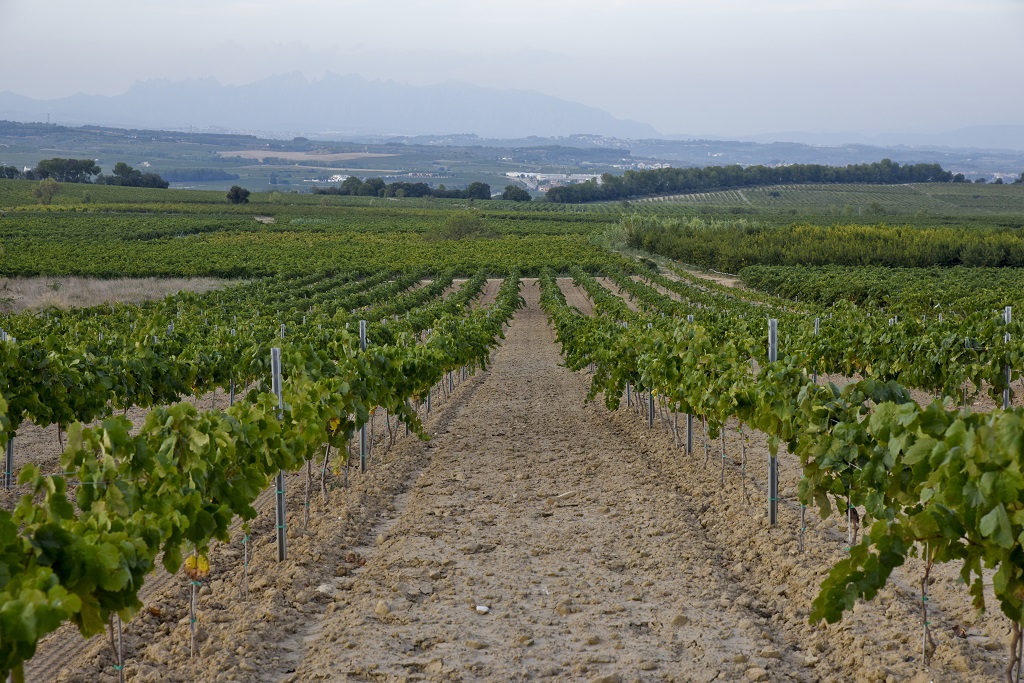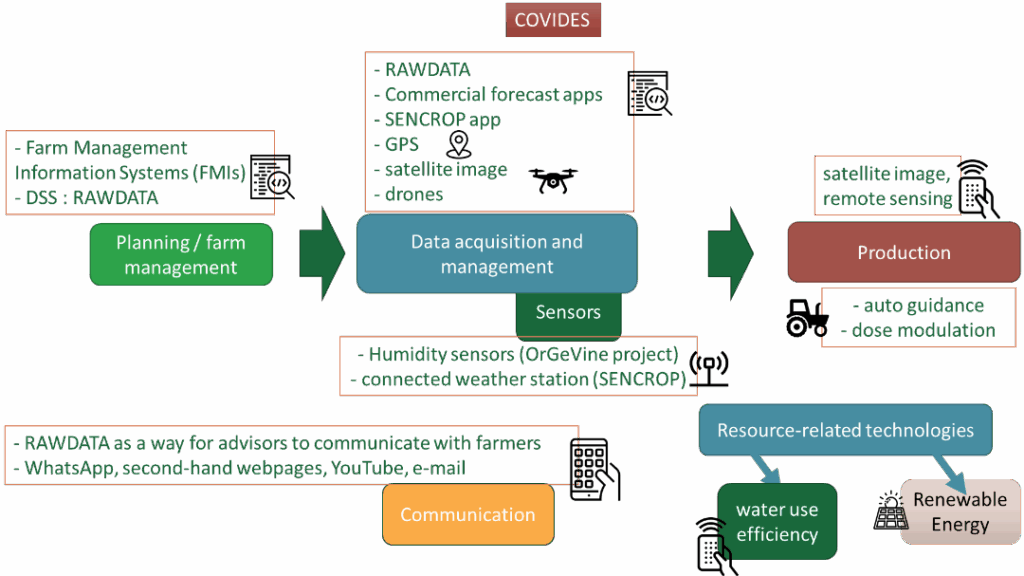Advancing Agroecological Vineyard Transition in Penedès Through Digital Innovation

Local context / Issue:
How to help agroecological farmers to develop a strong agroecological system and how to guide the conventional system farmers to do the transition to organic and agroecological system?
Showcase Outlook
The roots of the wine culture in Catalonia go deep. Here, vineyards have shaped the physical but also the social landscape of the country for more than 2.000 years. Its influence reaches till today’s cultural heritage and far beyond. In economics, for instance, the wine sector has a turnover of more than 3 bilion euros, representing 1,2% of the national GPD. In Catalonia, tradition and money weigh too much. And in the wine sector, both are heavy to carry.
This is the crossroad where COVIDES stands. It is the biggest wine co-op of the 72 that exist in the country. Founded in 1963, it has more than 700 members managing nearly 2.000 hectares in the heart of the Penedès Wine Appellation. However, the huge change experienced by the wine sector in recent years, the threat of climate change, the ageing of winegrowers and the lack of generational succession constrain its present and its future. From its productive capacity to, for instance, the adoption of new digital tools.
Because, as seen in the PATH2DEA workshops, while water scarcity, adaptation to drought, the decrease in wine consumption among young adults, and bureaucracy remain their main concerns, concepts like sustainability, digitalisation, and agroecology have started to gain more and more relevance in their priorities. This does not mean they were not sensitive to these issues — on the contrary, given their current needs and thanks to the initiative of the technicians from COVIDES and the Catalan Federation of Cooperatives (FCAC), farmers receive advice, training, and mentoring on the best tools suited to their needs. In fact, their short-term outlook and the pressure to make a living from farming, to survive in an increasingly uncertain context, make them aware of the importance of adopting new technologies and digital tools as the most appropriate way to manage and understand modern viticulture.
Several farmers who participated in these workshops expressed the importance of ensuring that their real, day-to-day needs are taken into account by researchers and other sector stakeholders, as they feel there is currently a disconnect between the academic and research worlds and the challenges they face daily. Nevertheless, during the workshops, COVIDES farmers and technicians highlighted the usefulness of digital tools and technologies in optimizing their resources, facilitating decision-making, managing information, and reducing the increasing uncertainty they face in their daily work.
Although they value projects like PATH2DEA, as well as other regional, national, and European initiatives in which they have participated or are still involved, some of them believe that research and academia often fail to integrate the business perspective — specifically, the perspective and needs of small and medium-sized winegrowers leading family-run businesses with very concrete challenges.
From their point of view, in the area of digitalisation, there is a lack of scientific and innovation projects that address the needs of small producers, who do not have sufficient resources to invest in advanced technologies or costly long-term management tools.
Living in a world of tangible things, mainly focused on producing tons of grapes, makes them very aware of their daily needs and sometimes creates difficulties in having a broader view of the value chain. Fortunately, the cooperative model enables producers to be active participants in the value chain and adapt to market demands. The Covides cooperative is made up of producers who, from the outset, have opted for vertical integration and are part of the wine value chain not only as grape producers but also in winemaking, marketing, commercialization and distribution. Moreover, they participate in the wine cluster (INNOVI), which, as well as FCAC, promotes local products to consumers and works on evaluating and adapting the entire chain to new consumption patterns. In this way, the cooperative model plays a key role in the regional, national, and European food system.
Projects like PATH2DEA help highlight both the work done and the work still to be done in the field of digitalisation in agroecological grape production and throughout the wine value chain developed by agri-food cooperatives like Covides. PATH2DEA contributes to narrowing the gap between the real needs of farmers and the implementation of technologies and digital tools in the agri-food sector in general, and in agroecological production in particular, thereby driving the sector forward and keeping it alive and rooted in the territory.
Showcase at a glance
Showcase representative name: Covides Cooperative.
Challenge of the showcase: “How to make the agroecological strong system and help conventional farmers make the transition to agroecological system in the Penedès area by means of DT?”
Type of production: Wine and Cava production (vineyard sector).
Type of agroecology: Organic or conventional using only treatments allowed for organic production.
Participants: 10 farmers (9 men and 1 woman) and 4 technicians (3 men and 1 woman).
Showcase representative: Diana Molina Delgado
rdi(at)fcac.coop / fcac(at)fcac.coop
Location: Sant Sadurni de l’Anoia, Catalonia, Spain
Website: https://www.covides.com/

Testimonials
- Podcast with the showcase ambassador :
- Farmer’s interviews:
Links???
Mapping of digital tools used in COVIDES’ showcase

A diversity of tools is used in the showcase, covering most of the range of existing digital technologies and supporting a diversity of operations on the farm. The picture illustrates the main tools for the main processes on the farm. More details about the tools are available in the Digital Tools section (link)
Usability/applicability of DTs: Main drivers, barriers, risks and trends

Drivers: #save & visualize data #simplicity of the tool #profitability #reliabilityWhat would make COVIDES producers use more DTs is that they are easy to access and use, that they have a good price/efficiency ratio, and their reliability. It is important that DSS can provide integrated information as well on climatic conditions as on possible diseases and pests. This is also a trend for them: the need for one platform that connects all the tools.

Barriers: #lack of collaboration/knowledge/training #ROI & cost #age #poor connectivityThey consider as barriers the administration procedure that induces resistance, lack of training, high costs of DTs at farmer level, lack of interest for elder farmers, uncertain return on investments, poor Wi-Fi network and lack of alternative when technology fails.

Risks: #dependency #splitting due to high costThe attendees see as risks the possibility of forgetting knowhow due to the use of DTs, of trouble to follow uploads and resistance to training for the use of DT; also waste of time (no usability of some tools), cost, dependency, inaccessibility.

Looking to the future/trends: #weather forecast #automation & robotics Control & forecast of weather, sensors to monitor meteorological and agronomic conditions, management of uncertainties, optimisation of resources & automation and robotisation when farms lack skilled labour were the needs expressed.
The added value of the used digital tools and technologies
When grouped according to specific management activities, digital tools and technologies become key enablers of the agroecological transition. Their combined use supports more resilient and sustainable farming practices. Explore how digital tools and technologies enhance this showcase management—step through the timeline of its core activities.
More details about the tools are available in the Digital Tools section (link).
Wine grapes production
What do farmers from this showcase expect as improvement or new function for digital tools to enhance their transition to more agroecological practices?
The region of COVIDES faces climate change issue (e.g. water scarcity, drought…), which is an opportunity for digitalisation uptake to maintain agroecological practices in future conditions. Economic issues are amongst the reasons for low uptake of tools, as well as lack of awareness regarding existing tools, and user-friendliness. Another reason expressed for implementing DTs would be to have dedicated tools for their production system (winery), or even for each client. Besides, they would like to dispose of more integrated tools for data collection and registration. To improve the tools’ qualities, they emphasise the role of a good co-construction approach. They are aware of what digital tools can give to them: improve the farmer’s day to day, reduce bureaucracy when they work well, however they are somehow skeptical regarding how they can help specifically regarding agroecological transition. They wonder about a tool to integrate all administrative works for land management and for labor control.
Farmers as an individual feel quite disconnected from the supply chain (they deliver the grapes to the cooperatives but are not anymore involved afterwards), so it is hard for them to think about which tools to implement or improve at the supply chain level. Fortunately, the farmer is not alone. COVIDES operates as a cooperative, and all decisions are made by a Board of Directors composed of elected farmers who are advised by the general manager and by agronomic, commercial, and other technical specialists. They can think about traceability monitoring tools for logistical purposes, or informative tools on consumption trends for production planning.
In the cooperative system, cooperative and technician advisors help farmers in the connection between them and the supply chain. The cooperative represents farmers’ interests in the sectorial tables, and the COVIDES group of technicians works on the integration of the more appropriate digital tools to facilitate farmers’ daily tasks. Then, COVIDES cooperative and its technicians’ team are key factors to help farmers in the transition to more sustainable agroecological, organic, and conventional production systems through digitalisation.
More details on the gaps found in the 6 showcases can be explored in the Gap Analysis section (link).

